Unlike Asus and Gigabyte, which have also switched to 2.5-slot designs on the cooler, EVGA (and fans of a narrow structure) stays true to the GTX 1080 Ti FTW3 Gaming and squeezes the technical possibilities of dual-slot design to the end of the year. physical limit. This has its charm, because you won't find too many narrow GeForce GTX 1080 Ti on the market at the moment and the reference design is loud, hot and also a little bit… Limited.
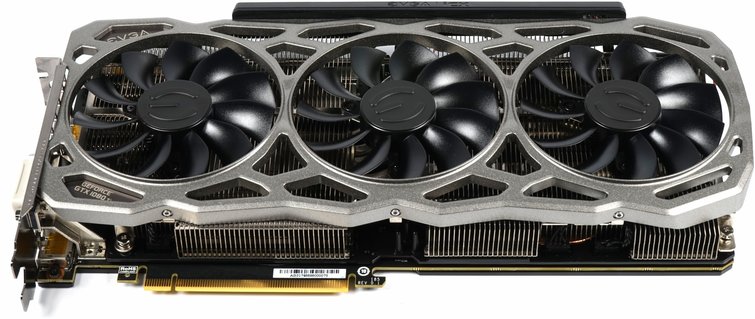
Since the specifications of the standard or Reference models ("Nvidia GeForce GTX 1080 Ti 11GB in test") don't let gaming target group-like cast, then it has to be a little more. Today's test will reveal whether and how the balancing act between extra power and restriction in the cooler depth succeeds and what our ears ultimately say about it.
Since the actual performance of all board partner cards depends more on the actual boost clock achieved, and thus causally depends on the cooling, the power target and above all the quality of the respective chip, any test based only on benchmark bars is more of a Random snapshot of a single specimen. This is precisely why we have focused on the actual technical implementation of each model and have been able to document this very well with our equipment.
Unboxing, dimensions and connections
More being than appearance? Despite its rather slender, lateral profile, the EVGA GTX 1080 Ti FTW3 Gaming is by no means a toy card and not an easy appearance. At 1348 grams, it weighs relatively much and hardly has to hide behind its competitors. This also applies to the installation, which can bring proper load to the motherboard.
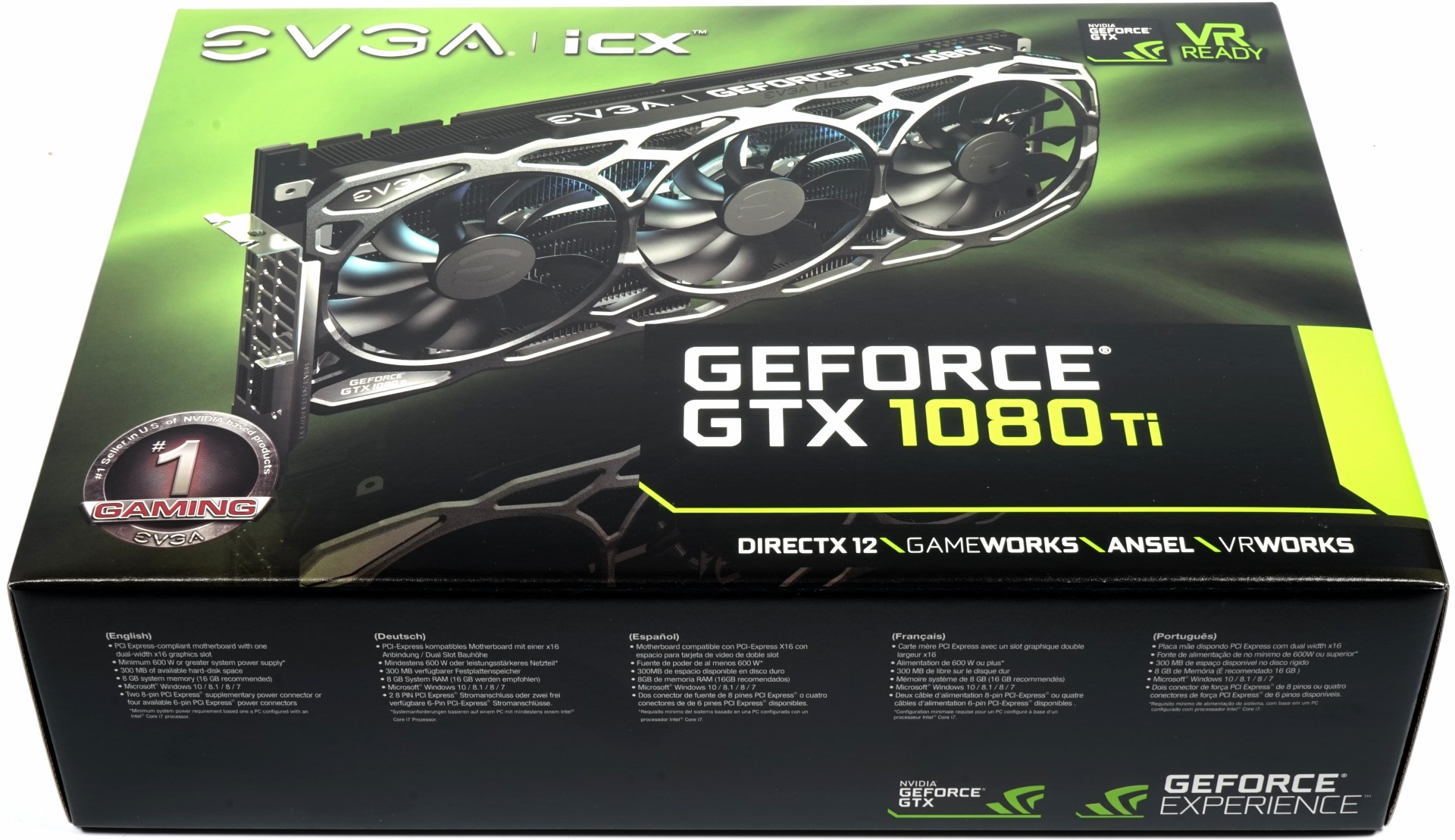
With a stately 30.2 cm real installation length (outer edge slot aperture until the end of the cover), a height of a whopping 14 cm (upper edge motherboard slot to top edge cover) and a built-in depth of 3.5 cm, the dual slot card is already a real size in the graphics card cosmos, which is the back then again approx. 0.5 cm of space is required, which should be taken into account in large tower coolers.
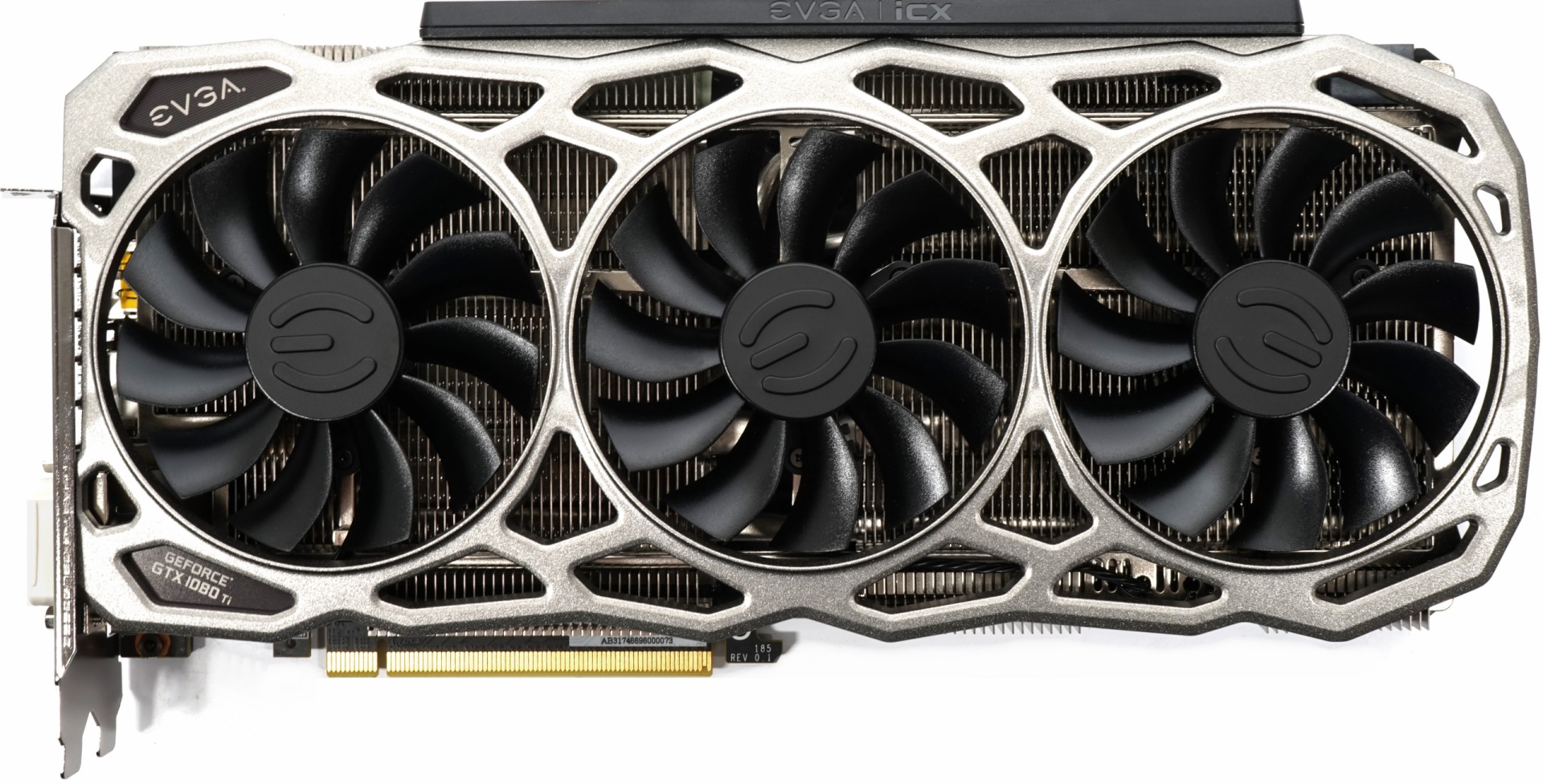 |
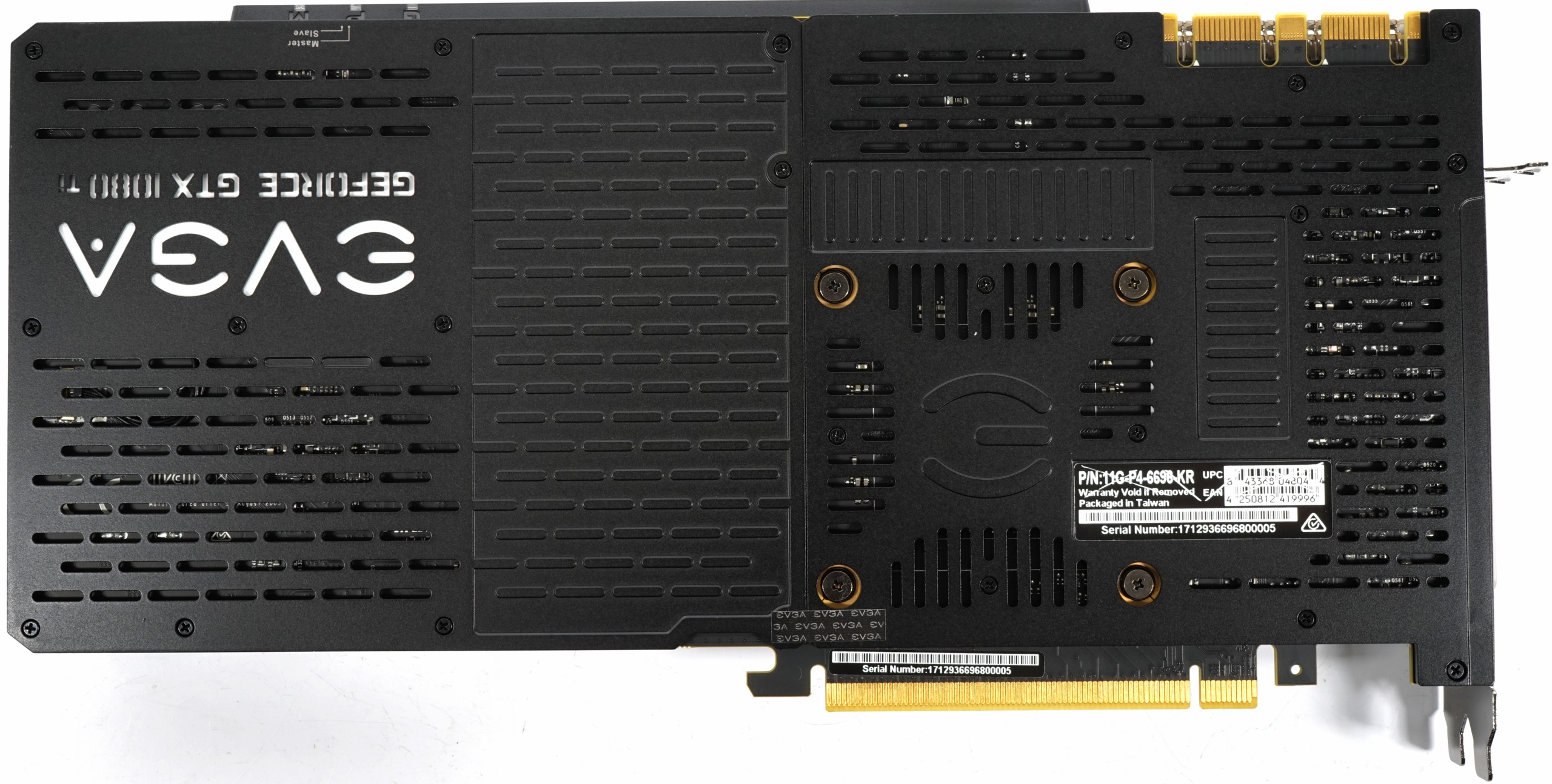 |
The material mix of predominantly plastic for the cover still feels reasonably valuable, especially since the cover suggests a rather good aluminium casting imitate when not too closely looked at. It is only when you touch that you really notice the fallacy. The two-part backplate is also a passive cooling surface, but additional details.
The top is characterized by the LED backlit "EVGA" and "Geforce GTX 1080 Ti" lettering, as well as an LED indicator labeled "FTW3". The two 8-pin power supply connectors sit unturned at the top of the board.

The bottom and top show the vertical slat orientation of the cooler and the absence of a real VRM heat sink that could actively cool other assemblies. Instead, there sits on the board a kind of flat cooling frame, about which there is of course still enough to write later.

The end of the card shows two 8 mm and three 6 mm heatpipes for the right part of the radiator structure. However, from this side the sixth, another 8 mm heatpipe, is not visible from the outside. But more on that later. As with Zotac, the variety of connections is based on standard costs from an HDMI 2.0 port, as well as three DisplayPort 1.4 jacks and a revived dual-link DVI-D connector (picture right). Nvidia had already saved it as a precautionary measure when it came to reference design.
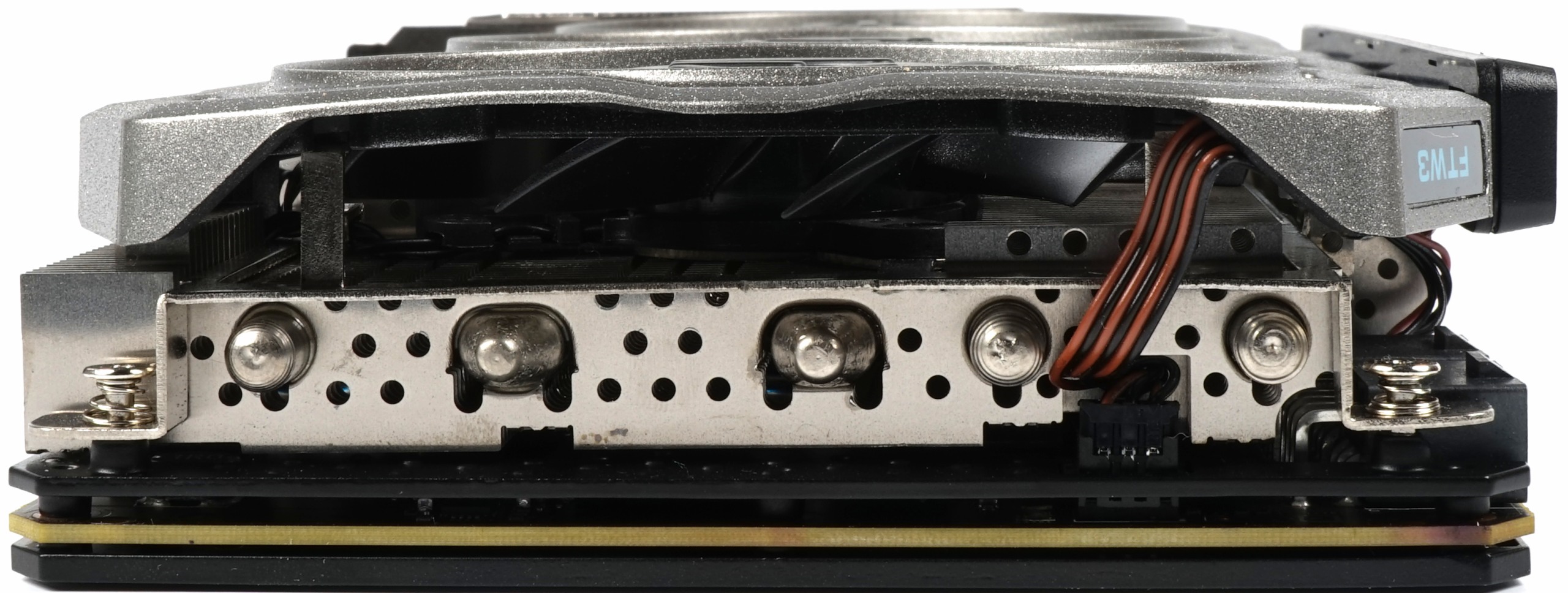 |
 |
Specifications
The GPU-Z screenshot shows us the most important key data in advance, whereby the actual boost achieved with our model was significantly higher:
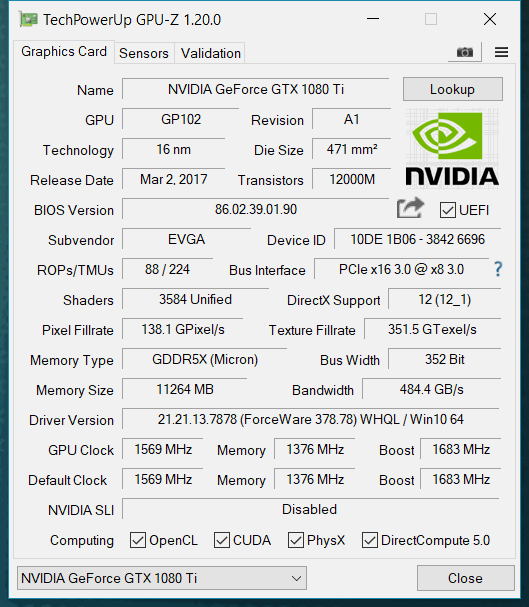
Finally, the whole thing again as a tabular comparison to the other relevant graphics card models:
| Nvidia Titan X – (Pascal) Mr President, I would like to |
Nvidia Geforce GTX 1080 Ti FE |
Evga GTX 1080 Ti FTW3 Gaming |
Nvidia Geforce GTX 1080 FE |
Nvidia Geforce GTX 980 Ti |
|
|---|---|---|---|---|---|
| Gpu |
GP102 | GP102 | GP102 | GP104 | GM200 |
| CUDA cores |
3584 | 3584 | 3584 | 2560 | 2816 |
| Base clock | 1417 MHz | 1480 MHz | 1569 MHz |
1607 MHz | 1000 MHz |
| Boost clock |
1531 MHz+ | 1582 MHz+ | 1683 MHz |
1733 MHz+ | 1076 MHz+ |
| Memory Size & Type |
12 GByte GDDR5X |
11 GByte GDDR5X |
11 GByte GDDR5X |
8 GByte GDDR5X |
6 GByte GDDR5 |
| The size |
471 mm2 | 471 mm2 | 471 mm2 | 314 mm2 | 601 mm2 |
| Technology |
16 nm | 16 nm | 16 nm | 16 nm | 28 nm |
| Transistors |
12 billion | 12 billion | 12 billion | 7.2 billion | 8 billion |
| Streaming Multiprocessors (SM) |
28 | 28 | 28 |
20 | 22 |
| GFLOPS (basic clock) |
10.157 | 10.609 | 11.068 |
8.228 | 5.632 |
| Texture Units |
224 | 224 | 224 | 160 | 176 |
| Texture fill rate |
317.4 GT/s | 331.5 GT/s | 351.5 GT/s |
257.1 GT/s | 214 GT/s |
| Rops |
96 | 88 | 88 |
64 | 96 |
| Pixel fill rate |
136 GPix/s | 130.24 GPix/s | 144.8 GPix/s |
114.2 GPix/s | 116.7 GPix/s |
| Storage data rate |
10 Gbps | 11 Gbps | 11 Gbps | 10 Gbps | 7 Gbps |
| Storage bus |
384 bits | 352 bits | 352 bits | 256 bits | 384 bits |
| Memory bandwidth |
480 GByte/s | 484 GByte/s | 484.4 GByte/s | 320 GByte/s | 336 GByte/s |
| L2 cache |
3 MByte | 2816 KByte | 2816 KByte | 2 MByte | 3 MByte |
| Tdp |
250 watts | 250 watts | 280 Watt (PT) |
180 watts | 250 watts |
Test system and measurement methods
The new test system and the methodology have already been described in great detail in the basic article "How We Test Graphics Cards" (English: "How We Test Graphics Cards") and therefore, for the sake of simplicity, we now only refer to this detailed Description. So if you want to read everything again, you are welcome to do so. However, we have improved CPU and cooling once again in order to largely exclude possible CPU bottle necks for this fast card.
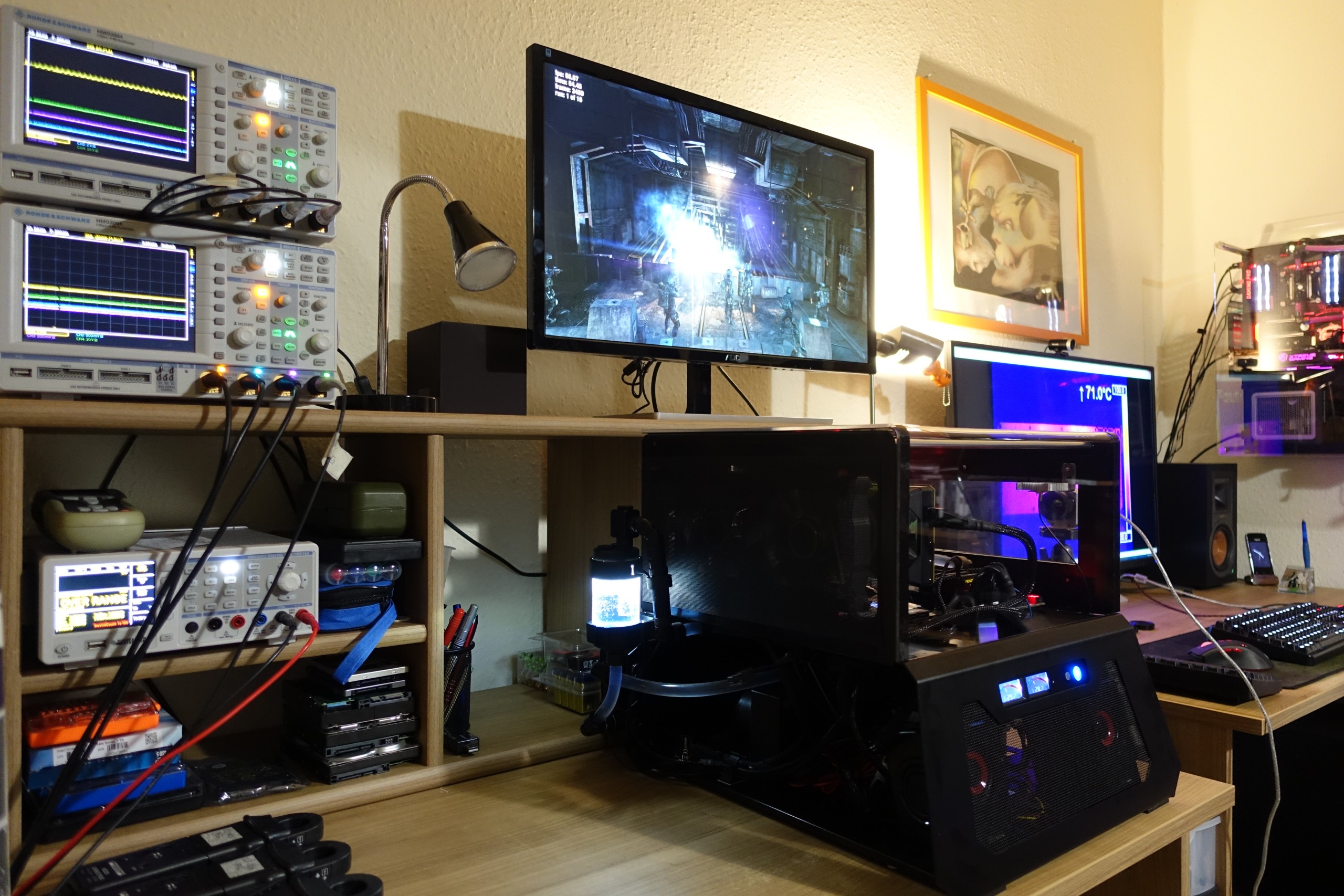
If you are interested, the summary in table form quickly provides a brief overview:
| Test systems and measuring rooms | |
|---|---|
| Hardware: |
Intel Core i7-6900K -4.3GHz MSI X99S XPower Gaming Titanium Corsair Vengeance DDR4-3200 1x 1 TByte Toshiba OCZ RD400 (M.2, System SSD) 2x 960 GByte Toshiba OCZ TR150 (Storage, Images) Be Quiet Dark Power Pro 11, 850-watt power supply Windows 10 Pro (all updates) |
| Cooling: |
Alphacool Ice Block XPX Alphacool Ice Age 2000 Chiller 2x Be Quiet! Silent Wings 3 PWM (Closed Case Simulation) Thermal Grizzly Kryonaut (for cooler change) |
| Housing: |
Lian Li PC-T70 with expansion kit and modifications Modes: Open Benchtable, Closed Case |
| Power consumption: |
non-contact DC measurement on the PCIe slot (Riser-Card) non-contact DC measurement on the external PCIe power supply Direct voltage measurement on the respective feeders and on the power supply 2x Rohde & Schwarz HMO 3054, 500 MHz multi-channel oscillograph with memory function 4x Rohde & Schwarz HZO50, current togor adapter (1 mA to 30 A, 100 KHz, DC) 4x Rohde & Schwarz HZ355, touch divider (10:1, 500 MHz) 1x Rohde & Schwarz HMC 8012, digital multimeter with storage function |
| Thermography: |
Optris PI640, infrared camera PI Connect evaluation software with profiles |
| Acoustics: |
NTI Audio M2211 (with calibration file) Steinberg UR12 (with phantom power for the microphones) Creative X7, Smaart v.7 own low-reflection measuring room, 3.5 x 1.8 x 2.2 m (LxTxH) Axial measurements, perpendicular to the center of the sound source(s), measuring distance 50 cm Noise in dBA (Slow) as RTA measurement Frequency spectrum as a graph |
































Kommentieren